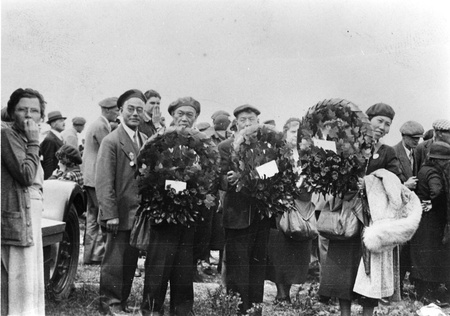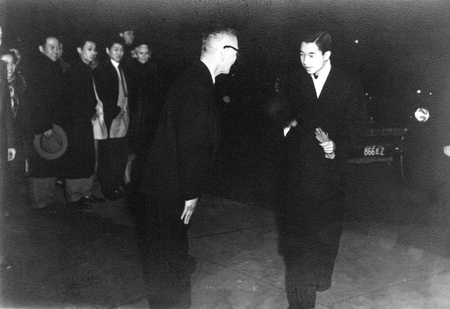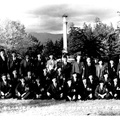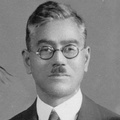Saburo Shinobu was the first Japanese Canadian to earn the degree of Chartered Life Underwriter, after ten years of correspondence courses from the University of Toronto. At that time, of 700 underwriters in B.C., only 20 had obtained this diploma. He sold insurance for Manufacturers Life to Nikkei who lived all over BC. He travelled constantly, and due to his work, acquired a large network of friends and acquaintances.
Sada ran a finishing school for young Japanese Canadian women teaching dressmaking, cooking, flower arranging, and needlework, and she shared office space at 302 Alexander Street near the Vancouver waterfront with Saburo.
As he was one of the few Issei who could speak English fluently, knew many people in the province, and was well-travelled, he became a respected leader in the Japanese Canadian community of Vancouver. He was accused of being a spy for Japan, by hakujin living on Vancouver Island, for the same reasons.
In addition to his insurance work and his Canadian Legion duties, Saburo volunteered on the board of the Powell Street Japanese United Church, the Vancouver Japanese School Maintenance Association and Asahi Park Association (he was a supporter of the well-known Asahi baseball team and an excellent baseball player himself). His family said that he was rarely home, as he was always travelling for work or at an important meeting.
One of the most important events in Saburo’s life was to attend the unveiling of the Vimy Memorial in France in 1936 as a representative of Legion Branch 9. He was given this privilege by the Legion because of his work in obtaining the vote for veterans in 1931, and for obtaining fishing rights in 1930 for Japanese Canadian veterans equal to rights of Canadian veterans. Saburo, WW1 Veteran Bunshiro Furukawa (secretary of Legion Branch 9), and businessman Eikichi Kagetsu (president of the Canadian Japanese Association) were the three Japanese Canadian delegates among 6000 Canadian pilgrims. They are shown at the wreath-laying ceremony at the Vimy Memorial in Photo F. Mrs. Kagetsu is on the right side of the photo.

This is a link to the diary that Saburo Shinobu wrote about his participation in the Vimy Pilgrimage, which was translated from Japanese into English by Kazuko Yatabe (daughter of Saburo Shinobu) and Eiji Yatabe, and eventually made available online by Library and Archives Canada.
Click here to view: (Image 230 to 279)
The diary has been quoted in many publications about the Vimy Pilgrimage. After crossing the ocean, the pilgrims were welcomed with wild enthusiasm by the French during their visits to towns, cemeteries and former battle sites. Saburo described the dramatic unveiling of the monument on July 26 by King Edward VIII, memorial service and address by the French president.
The pilgrims were welcomed by the British Prime Minister at Westminster Hall in London. They attended a service at the Whitehall cenotaph. At Buckingham Palace, Saburo was introduced to the Duke of Gloucester (brother of the King) by Vancouver members of the Canadian Legion. It was such a contrast to the way that he was treated by the Canadian government six years later.
Even in translation, the character of this man is apparent: his generosity of spirit, sense of humor, optimism, and above all, his determination to get recognition for the Japanese Canadian veterans.
When World War II broke out, the Japanese Canadians, including WW1 veterans, were evacuated from their homes in B.C. They were scattered to internment camps in the B.C. interior, to road construction camps across Canada, and to sugar beet farms on the prairies. A temporary internment camp was established at Vancouver’s Hastings Park, and together with World War 1 veterans, Saburo became one of the security guards there.
In September 1942 the Shinobu family was interned at Kaslo, a ghost town in the interior of southeast B.C.
During World War II, the Japanese owners of property on the B.C. coast had their houses, businesses and possessions sold without their consent by the Custodian of Enemy Alien Properties after they had been displaced from their homes. A large amount of the proceeds was used to fund the internment. The Japanese who were scattered throughout Canada contacted each other and formed a Japanese Property Protection Association and Saburo became the general secretary of that organization while based in Kaslo. After a great deal of inconvenience, this group brought a suit against the Secretary of State, but lost at the Ottawa Exchequer Court trial held the following year.
After the war, when Japanese Canadians were ordered to move “back to Japan” or east of the Rockies, the Shinobu family moved to Toronto.
Soon after the end of the War, several hundred Japanese families received deportation orders and there was great confusion in the Japanese Canadian community. Religious leaders and influential citizens of Toronto, with the intention of forcing a change in the government’s attitude, took the matter to the British Privy Council, and the Japanese residents in Toronto formed an association to protect the rights of the Japanese-Canadians, with Saburo as its vice-president.
It was very difficult to find work in Toronto due to the racism and anti-Japanese sentiment that remained. Saburo worked in a factory and also in a laundry room at one of the hospitals in Toronto, thanks to a friend from his church work in Vancouver and Toronto, Miss Florence Bird. In Toronto, Saburo worked with others on the JCCD (Japanese Canadian Committee for Democracy). Their major objective, to obtain the franchise for all Japanese Canadians, was achieved in 1948. Eventually he resumed work with the Manufacturer’s Life Insurance Company.
As the social welfare convenor and then the General Secretary of the Toronto JCCA (Japanese Canadian Citizens’ Association) Issei-bu, he organized the work of the Japan Relief, to collect, package and send clothing to post-war Japan.
Saburo Shinobu helped to organize the visit of Crown Prince Akihito of Japan to Toronto in April 1953.
Photo G was taken outside the Toronto Japanese Language School. It shows Saburo greeting the Crown Prince, who was 19 years old at the time.

Saburo’s health was poor after the move from Kaslo to Toronto. He had several heart attacks after he turned 60. He died in 1956, aged 68. He was a resolute and principled man who persevered against many obstacles for the rights of Nikkei in Canada.
*This article was originally published in Nikkei Images, Fall 2016, Vol. 21, No. 3.
© 2016 Susan Yatabe & Kazuko Yatabe






